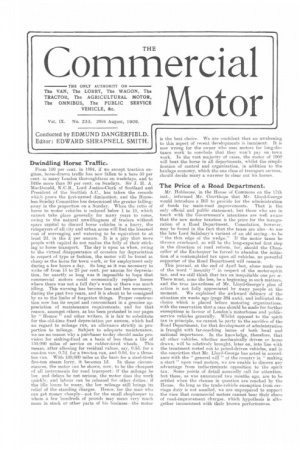Dwindling Horse Traffic.
Page 1

If you've noticed an error in this article please click here to report it so we can fix it.
From 100 per cent. in 1894, if we except traction engines, horse-drawn traffic has now fallen to a bare 50 per cent. in many London thoroughfares on weekdays, and to little more than 30 per cent. on Sundays. Sir J. H. A. MacDonald, K.C.B., Lord Justice-Clerk of Scotland and President of the Scottish A.C., has taken the records which prove the first-named diminution, and the Horseleas Sunday Committee has determined the greater fallingaway in the proportion on a Sunday. When the ratio of horse to motor vehicles is reduced below 1 to 10, which cannot take place generally for many years to come, owing to the natural unwillingness of traders without spare capital to discard horse vehicles in a hurry, the ratepayers of all city and urban areas will find the lessened cost of scavenging and watering to be equivalent to at least 2d. in the fa per annum. It is a pity that. more people with capital do not realise the folly of their sticking to horse transport. The day is upon us when owing to the virtual disappearance of occasion for depreciation in respect of type or fashion, the motor will be found as cheap as the horse for town work, or for employment only during a few hours a day. So long as it was necessary to write off from 15 to 25 per cent, per annum for depreciation, for exactly so long was it impossible to hope that commercial motors could economically replace horses where there was not a full day's work or there was much idling. This warning has become less and less necessary, during the past two years, and it is about to be consigned by us to the limbo of forgotten things. Proper construction now has its sequel and concomitant in a genuine appreciation of maintenance requirements, and for that reason, amongst others, as has been protested in our pages by " Homoe " and other writers, it is fair to substitute for the old-time fixed depreciation per annum, which had no regard to mileage run, an allowance strictly in proportion to mileage. Subject to adequate maintenance, we see no reason why a purchaser to-day should make provision for sinking-fund on a basis of less than a life of 150.000 miles of service on rubber-tired wheels. This means, after allowing for residual values, say, 0.5a. for a one-ton van, 0.7d. fur a two-ton van, and 0.0d. for a threeton van. With 100,000 miles as the basis for a steel-tired five-ton steam lorry, it becomes id. In these circumstances, the motor can be shown, now, to be the cheapest of all instruments for road transport: if the mileage be low, and delays be not serious, the motor does the work quickly, and labour can be released for other duties ; if the idle hours be many, the low mileage still brings its relief of the standing charges. Hence, for the man who can get money cheaply—not for the small shopkeeper to whom a few hundreds of pounds may mean very much more in stock or other parts of his business—the motor
is the best choice. We are confident that an awakening to this aspect of recent developments is imminent. It is now wrong for the owner who uses motors for long-distance work to conclude that they won't pay on town work. In the vast majority of cases, the motor of 1909 will beat the horse in all departments, whilst the simplification of control and organization, in addition to the haulage economy, which the one class of transport secures, should decide many a waverer to clear out his horses.






















